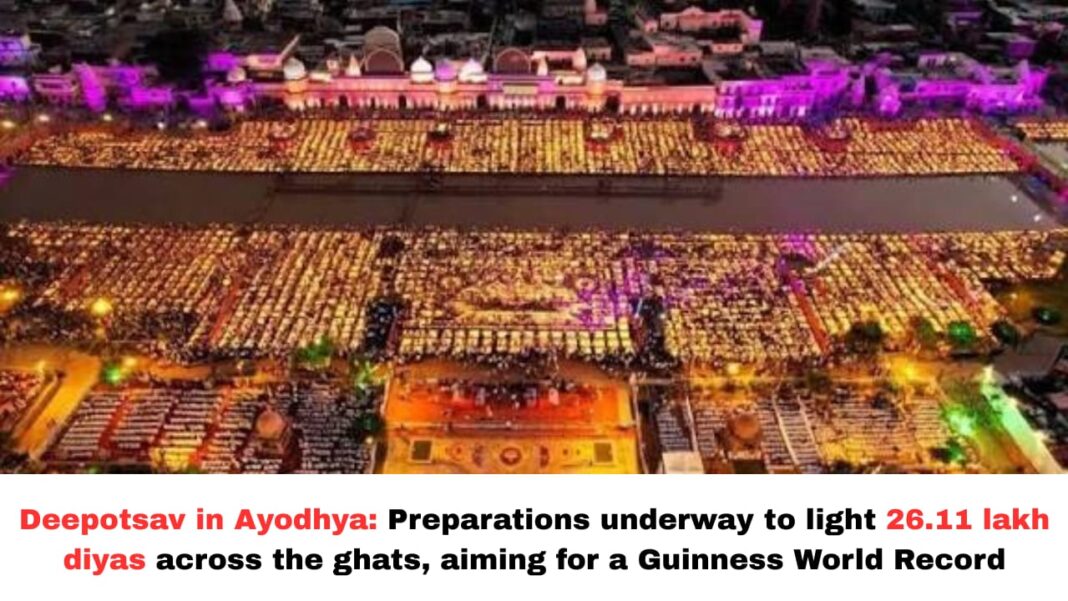Digital News Guru Uttar Pradesh Desk:
Ayodhya Gears Up for Grand Deepotsav 2025 with Record Ambitions
Ayodhya is in a festive fervor as it prepares for Deepotsav 2025 on October 19, aiming to outshine earlier editions by lighting 26.11 lakh (2.611 million) earthen lamps (diyas) along the ghats of the Saryu River.
The Uttar Pradesh government and local authorities are making concerted efforts to break the Guinness World Record previously set for the highest number of lamps lit in such a setting. This attempt continues Ayodhya’s tradition of turning Deepotsav into a spectacle of devotion, grandeur, faith, and community participation.

Scale, Additions & Innovations
Expanded Number of Ghats & Lamp Layout
This year, the illumination will stretch over 56 ghats, including the Laxman Kila Ghat being included for the first time. The famous Ram Ki Paidi stretch is expected to host the lion’s share of the lamps — approximately 15–16 lakh diyas.
Volunteer Force & Logistics
Around 33,000 volunteers are being mobilized from institutions, NGOs, and academia for the tasks of laying out, lighting, verification, and crowd management. A mock drill is scheduled on October 18 to test logistics, safety protocols, and the overall flow of the event.
Multiple committees (22 in number) have been set up under the aegis of Ram Manohar Lohia Awadh University and the district administration to handle different domains such as security, lighting, decorations, media, and crowd control.
Light, Sound, Tech & Thematic Displays
Deepotsav 2025 is not just about lamps — it’s being envisioned as a multimedia cultural extravaganza. Plans include drone formations, 3D holographic projections, laser mapping, and projection mapping across the ghats and temple precincts, telling episodes of the Ramayana. Further, 30 digital pillars along the Dharmapath (from the highway to temple entrance) will depict scenes from the life of Lord Ram, bringing an immersive visual narrative.

Historical Context & Records
Deepotsav began under the Yogi Adityanath administration in 2017 and has steadily scaled up each year in the number of diyas lit.
In 2023, Ayodhya lit 22.23 lakh diyas across 51 ghats, setting a Guinness World Record.
In 2024, the city pushed further: 25,12,585 diyas were lit and another record was set for 1,121 people simultaneously performing ‘aarti’ by rotating diyas.
This year’s target of 26.11 lakh diyas represents yet another incremental leap, aiming not only to reclaim the record but also to infuse the festival with new technological and cultural elements.
Significance & Expected Impact
Spiritual & Cultural Symbolism
Deepotsav is deeply tied to the Diwali narrative — the return of Lord Rama to Ayodhya after 14 years in exile. The massive illumination along the Saryu ghats is intended to evoke that mythic welcome, reinforcing Ayodhya’s spiritual identity. The convergence of tradition and spectacle also helps position the festival as a canvas for India’s civilizational narratives.
Tourism, Economy & Artisans
With hotels fully booked and great influx of pilgrims and tourists, the festival is a major boost to local economy and tourism. For potter communities, Deepotsav is a lifeline: large orders for diyas help sustain income generation, preserve traditional crafts, and attract artisanal labor back to rural zones.

Challenges & Verification
To succeed in the Guinness attempt, meticulous counting, accurate lighting (keeping lamps lit), and real-time verification (using drones and official observers) are essential. Disruptions, miscounts, or lamp failures can jeopardize the record. Managing crowd safety, fire risks, lighting resources (oil, wicks), and coordination across ghats are nontrivial logistical tasks.
In The End
Deepotsav 2025 is thus set to be more than a devotional gathering — it is a high-profile attempt to blend faith, culture, technology, and community at unprecedented scale. If successful, Ayodhya will strengthen its global spiritual brand and further deepen the link between its mythic legacy and contemporary spectacle.
You May Also Read: India’s Plan for a Space Station by 2035: ISRO to Launch First Module in 2027








